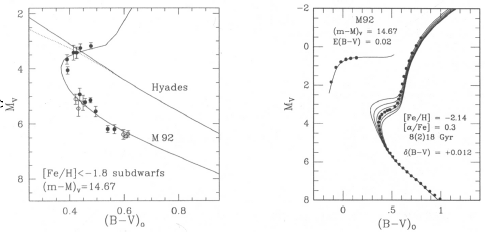No CrossRef data available.
Article contents
Distance and Age of M92 From Hipparcos Subdwarfs
Published online by Cambridge University Press: 14 August 2015
Extract

The parallax data gathered by Hipparcos for field subdwarfs allow a muchmore precise determination of globular cluster distances by direct sequencefitting than was previously possible. We determined the distance and age ofthe old, representative globular cluster M92 from a set of more than 500 subdwarf candidates with Hipparcos parallaxes. Precise [Fe/H] values were derived using the equivalent width of the CORAVEL cross-correlation function.
Our best estimate of the distance of M92 is (m — M)v = 14.67 ± 0.08 (including binaries with a statistical correction) or (m — M)v = 14.74 ± 0.08 (classic treatment, i.e. excluding binaries). The agreement of the cluster sequence with the position of extreme metal-poor field subdwarfs is remarkable [figure, left]. The distance found is slightly higher than previously thought. The corresponding ages, derived by comparing the luminosity of the turnoff and subgiant-branchstars with up-to-date evolution models [figure, right], are 14±1.2 Gyr or 13±1.2 Gyr respectively, implying a minimum age of 13 Gyr for the Universe.
Other authors have claimed that larger distances, and smaller ages, resulted from Hipparcos subdwarf parallaxes. Although there are some differences in the data sets used by each author, the main difference resides in the treatment of systematic and selection biases. We have examined at some length the biases affecting the determination of the mean luminosity of a set of subdwarfs selected in the usual way. By means of Monte Carlo simulations, we show that selection biases act in a direction opposite to the classic Lutz-Kelker bias affecting parallax data, and that they can be dominant. The biases introduced are of the order of 0.1 mag.
It is pointed out that, now that the whole Hipparcos catalogue is available, we shall be able to greatly reduce the systematic biases by refining the fitting procedure. Firstly, by imposing no [Fe/H] limits and fitting the subdwarf locus for all [Fe/H] values at the same time. Secondly, by imposing no parallax error limit and fitting the data in parallax space instead of magnitude space (comparing observed parallaxes directly with parallaxes predicted from the models).
Information
- Type
- II. Joint Discussions
- Information
- Copyright
- Copyright © Kluwer 1998

